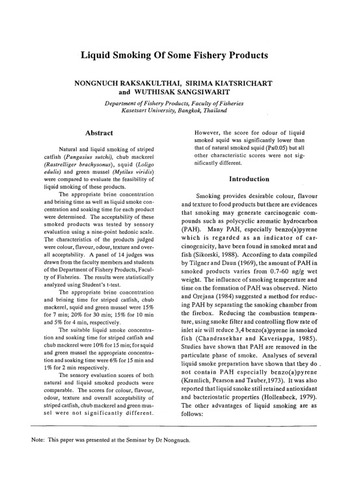Liquid smoking of some fishery products
Share
Abstract
Natural and liquid smoking of striped catfish (Pangasius sutchi), chub mackerel (Rastrelliger brachysonus), squid (Loligo edulis) and green mussel (Mytilus viridis) were compared to evaluate the feasibility of liquid smoking of these products.
The appropriate brine concentration and brining time as well as liquid smoke concentration and soaking time for each product were determined. The acceptability of these smoked products was tested by sensory evaluation using a nine-point hedonic scale. The characteristics of the products judged were colour, flavour, odour, texture and overall acceptability. A panel of 14 judges was drawn from the faculty members and students of the Department of Fishery Products, Faculty of Fisheries. The results were statistically analyzed using Student s t-test.
The appropriate brine concentration and brining time for striped catfish, chub mackerel, squid and green mussel were 15% for 7 min; 20% for 30 min; 15% for 10 min and 5% for 4 min, respectively.
The suitable liquid smoke concentration and soaking time for striped catfish and chub mackerel were 10% for 15 min; for squid and green mussel the appropriate concentration and soaking time were 6% for 15 min and 1% for 2 min respectively.
The sensory evaluation scores of both natural and liquid smoked products were comparable. The scores for colour, flavour, odour, texture and overall acceptability of striped catfish, chub mackerel and green mussel were not significantly different.
However, the score for odour of liquid smoked squid was significantly lower than that of natural smoked squid (P=0.05) but all other characteristic scores were not significantly different.
Suggested Citation
Raksakulthai, N., Kiatsrichart, S., & Sangsiwarit, W. (1991). Liquid smoking of some fishery products. In K. K. Hooi, K. Miwa, & M. B. Salim (Eds.), Proceedings of the Seminar on Advances in Fishery Post-Harvest Technology in Southeast Asia: Singapore, 6-11 May, 1991 (pp. 221-229). Singapore: Marine Fisheries Research Department, Southeast Asian Fisheries Development Center.

